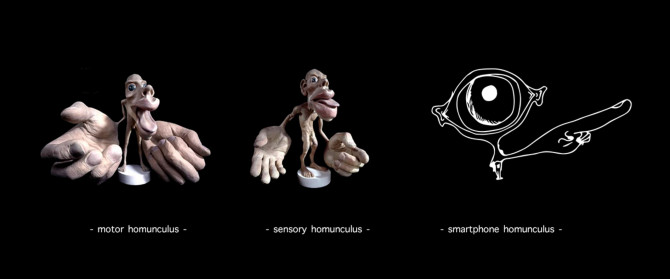Affiliate links on Android Authority may earn us a commission. Learn more.
Can apps shape our brains, thoughts, and personalities?

We recently talked about the ways smartphones have changed the world for the better over the last decade. While smartphones are shaping the world we live in, they also have a real impact on our inner world. Continuous interaction with our devices can change the structure of our brain. It can improve our cognitive abilities, and some say, reduce them. Let’s take a look at how our beloved phones can change the way we think and feel.
Smartphone usage alters our brains
Research shows that our brains gradually change, depending on how we’re using them. I’m sure this doesn’t sound like rocket science. A striking example of how our brains adapt comes from a study of London taxi drivers that found that the memory regions in their brains were much larger than in normal people. This is because, in order to be a registered taxi driver in London, you need to have the so-called “Knowledge” – a detailed command of London’s thousands of streets, shortcuts, and interest points, which requires strong spatial mapping. Consequently, the drivers’ brains’ memory regions adjust to store the huge amount of information. Mind you, this goes way back to the millennium, years before the smartphone revolution.

What about you? When was the last time you asked a person on the street for directions? My bet is the frequency of that happening has declined dramatically since Google Maps was introduced.
So far, there is no research specifically on this topic. But my feeling is that our ability to read maps must be improving simply because we started doing it much more often than we used to. Not convinced? Consider how valuable the ability to locate a rare Pokémon in Pokémon Go is! Surely games like Pokémon Go are designed around giving us incentives to use such skills effectively and improve on them to perform even better.
A recent study showed that touchscreen phone users have a greater representation of their thumb, index and middle fingers in their brain. That tells us that prolonged smartphone usage enlarges the area in our brain where our limbs are represented.
Some of you might have heard of the homunculus, an imaginary creature whose body parts are proportional to the space each limb is represented in the brain. The smartphone homunculus is a little bit exaggerated, but I still think it illustrates the point quite well.

Some experts warn that enhanced blood flow to certain regions of the brain may increase the risk of tumors. But, so far there is no concrete evidence that brain cancer incidence has increased in the last decade, and particularly in people who use their smartphones intensively.
It will be interesting to repeat these studies a few times in the next decade, because the average age of the smartphone user is rapidly declining and its long-term effects in younger brains is mostly unknown.
Think of the children
As adults, we have to take responsibility for the proliferation of smartphone usage among our kids. I’m sure we all have seen adults who allow their children to play with their smartphones just to have a little time for themselves. The brief introduction quickly leads to a point of no return, as high-resolution screens open up vibrant, animated, and attractive world for children to explore.
With rapidly advancing technology, the children of today are being exposed to a much richer information load, in almost every respect compared to previous generations. This change will influence their learning abilities, as well as their learning styles.
Even for us adults, it’s becoming more and more difficult to keep our attention on one thing. Not when there are so many digital distractions – top 10 lists! videos! adverts! discounts! new product reviews! – fighting for a piece of our time. By this point, I’m sure I lost some of my readers to something else.
It’s possible that tomorrow’s adults will have much shorter attention spans. They may be more likely to develop “sensation seeking” personalities, mainly because technology is accelerating everything and the “hype” fades away rather quickly! On the bright side, they will develop much better abstract thinking abilities, which will help them excel in fields such as software engineering. It is likely that both of these scenarios will happen.
What about those left behind? The kids who don’t get to play with the latest tech from age 2? They may suffer, unless we adopt smart devices in our education system on a wide scale. And we don’t need to invest billions in it. A good example of this is how the dirt cheap virtual reality headset Google Cardboard is used in schools to give children virtual tours of attractions from around the world. Even the old-school Nexus 5 is enough to make a difference.
The excitement of these children is surely admirable! I think the sole aim of mainstream education should be promoting enough curiosity (to seek more knowledge), and smart devices have a huge potential to help us accomplish this.
Apps with a pinch of science
There is an emerging trend in science which is called “gamification.” With this approach, scientists bury their research question in the context of a game which is then introduced to the general public to collect data in an indirect way. We recently talked about one example, called Quantum Moves, in which scientists were seeking inspiration from the intuitive ways that people can solve quantum physics problems. Without doubt, exposure to this kind of problems would help us develop better abstract thinking and problem solving abilities.
Great Brain Experiment, which is an app designed by University College London, is another example where science meets mobile technologies. It contains a number of games that involve exercising your memory or estimating financial risk. Scientists use the data collected from thousands of people to understand how the brain works by developing mathematical models to explain how people make decisions. This is fairly important, because we can think of our daily life as a series of decisions that we make, from when to eat and to when to leave work, all the way up to judging which new smartphone is the best.
Another research from University of Oxford, recently used VR to help people manage severe paranoia. By exposing agoraphobic people to crowded places that they usually try to avoid, researchers showed that even 30 minutes of VR training is enough to make a difference on how the mind works.
In our work, we apply similar gamification principles to another public health issue and investigate to see if playing one version of a game can change people’s learning styles and protect them against future episodes of depression. However, whether repeated exposure to one type of problem solving can improve cognitive abilities proportionately is not always clear-cut, and more data is needed before we can confidently say that these approaches will work for the wide majority of people.
Games and cognitive control
I don’t know if this will actually happen, but after the recent tragic mass-shooting that took place in Germany, there was a set of rumors that “violent” games might be banned in Germany. It is easy to understand this logic, that violent games inspire people to violent behavior and they reduce people’s ability to control acting on violent ideas. But a counter-argument is also possible, that “violent” games help people by giving them a virtual world to actualize such ideas, so that they can control them in daily life.
The key problem here is where to draw the line. Maybe it is the “graphical violence” which is more problematic. Otherwise, think of Mortal Kombat vs Pokemon Go, both available in app stores. In these games the underlying idea is the same (defeating the opponent), but the implementation is quite different. Perhaps training our brain to be less influenced by all the graphical violence that we are exposed to needs to become an educational priority too.
Wrap up
The smartphone revolution is surely influencing the structure of our brain and our thinking. The technology seems to advance far quicker than we can adjust. And, so far, the capacity of scientists to understand the long-term effects of heavy smartphone usage is lagging behind. Instead of being dragged away by this massive revolution, I think it’s important to take a few steps back to check how much we are, as individual customers, harvesting the potential of smart devices and think of ways to minimize their negative effects.